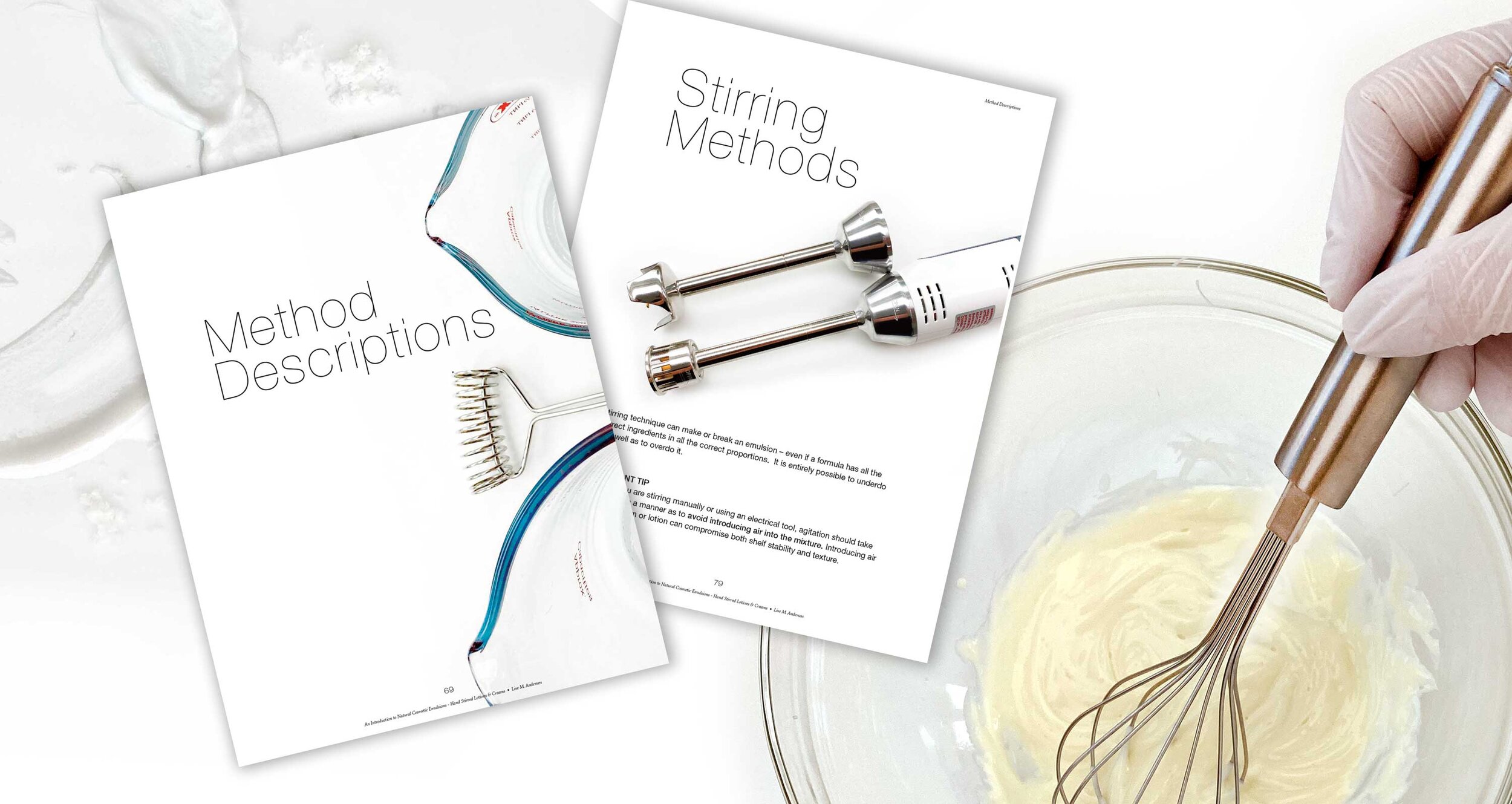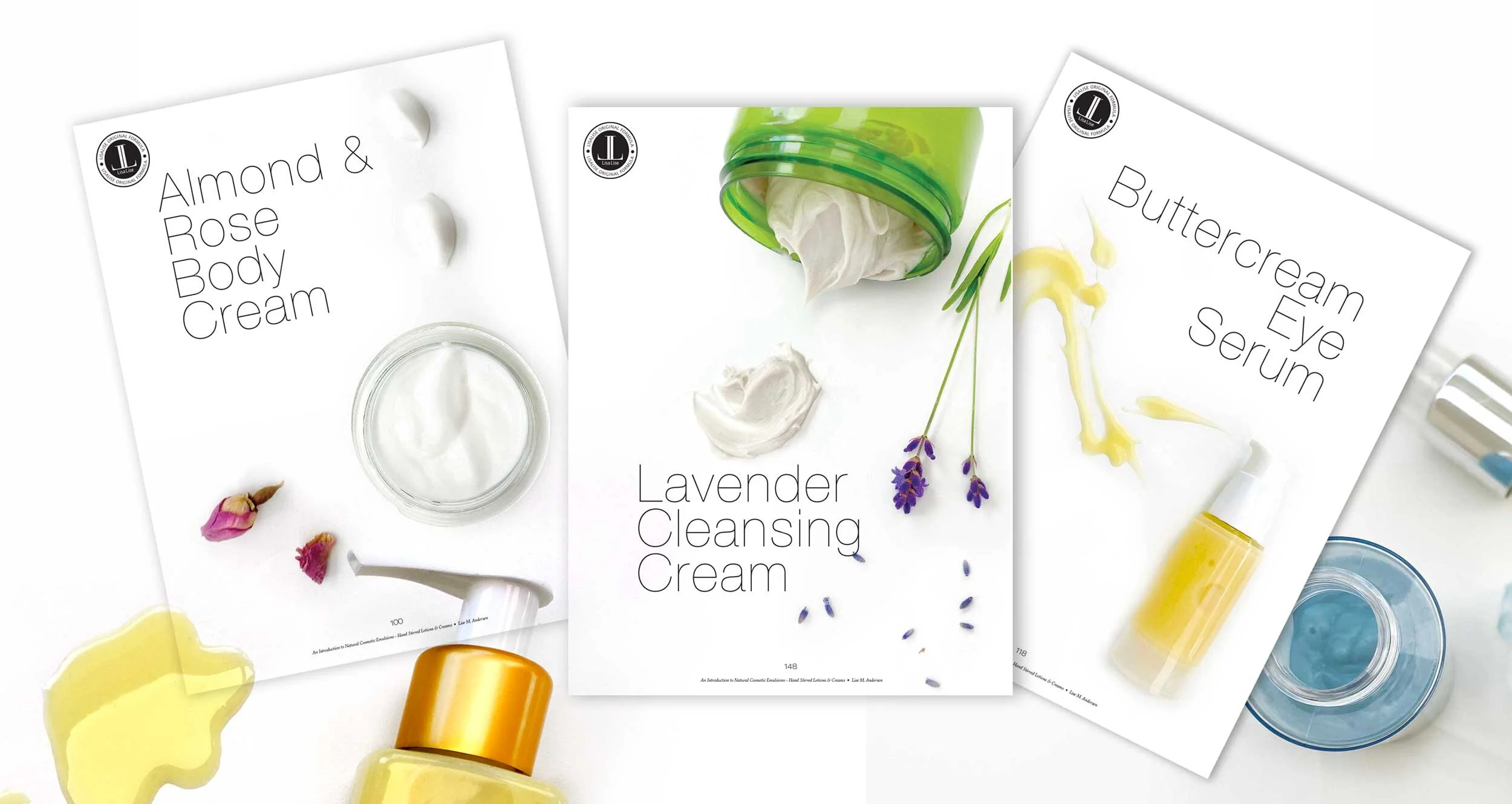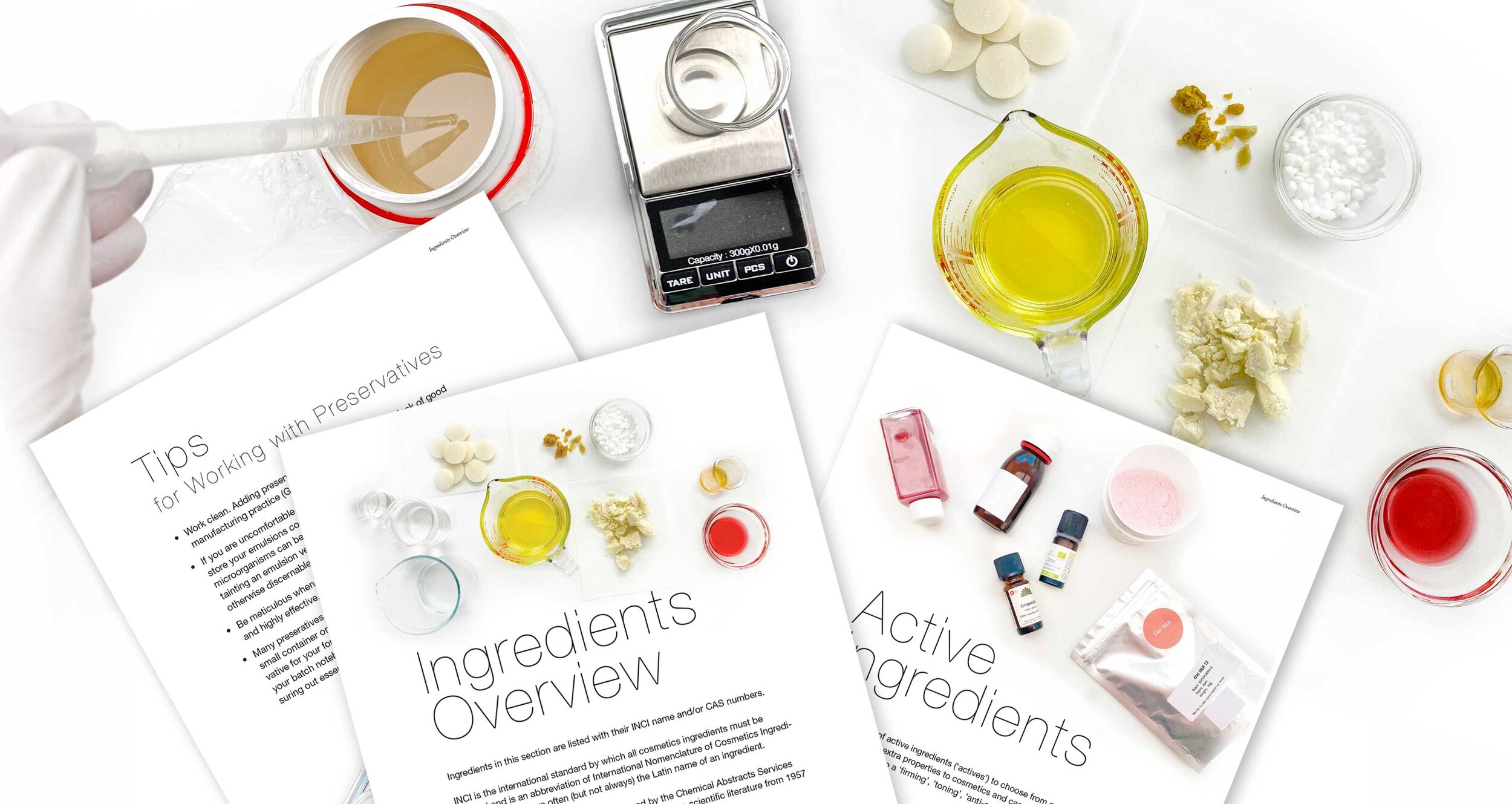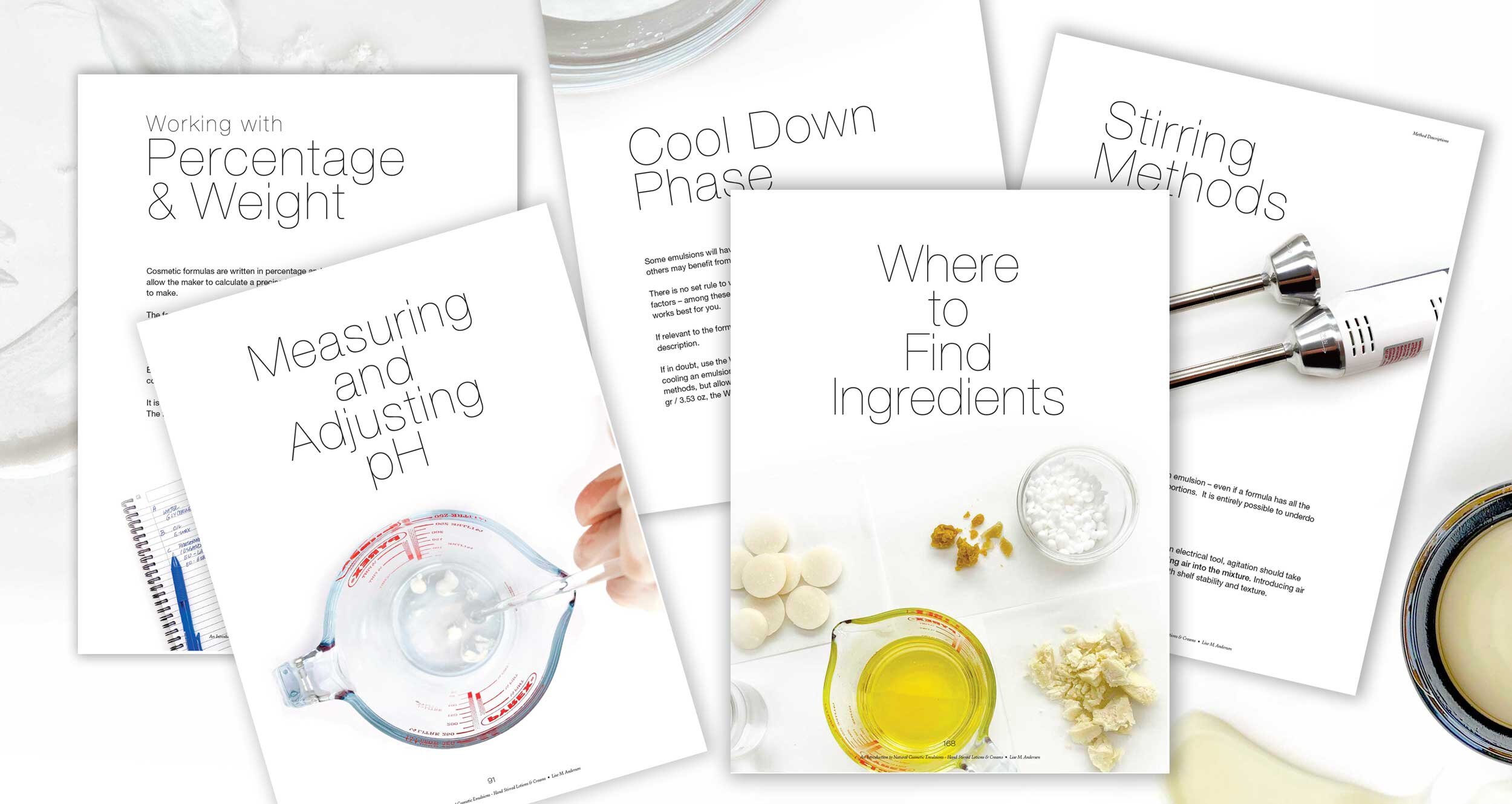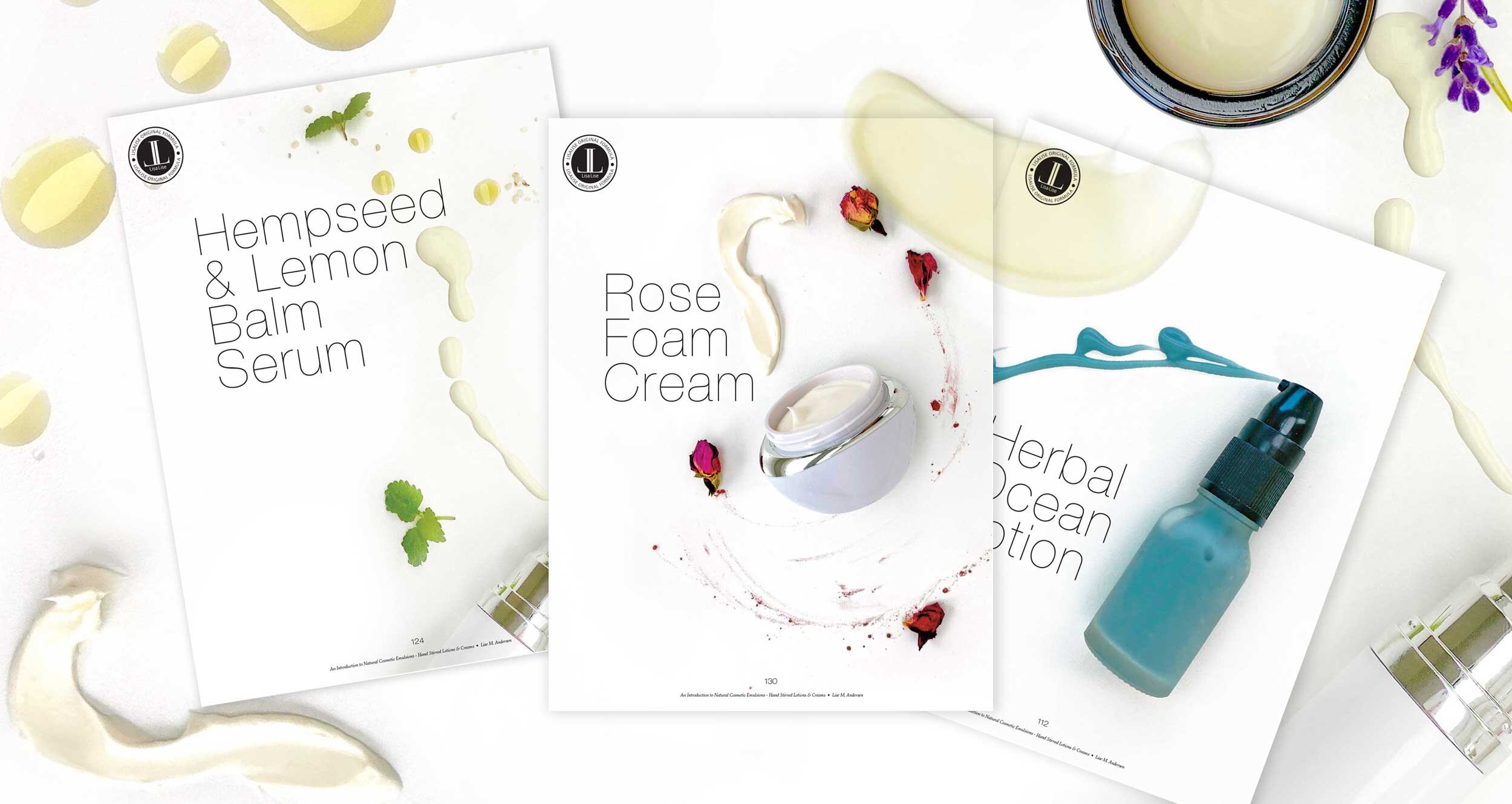LisaLise Shop
Find E-books that teach you how to make your own plant-based extracts and cosmetics.
An Introduction to Natural Cosmetic Emulsions - Hand-Stirred Lotions and Creams
An Introduction to Natural Cosmetic Emulsions - Hand-Stirred Lotions and Creams
E-BOOK - INSTANT DOWNLOAD
Learn how to make and customize your own beautiful natural lotions and creams using globally available ingredients and a few simple tools. This 178 page introduction to hand-stirred emulsions includes a wide range of textures and applications: from light cleansing milk and delicate eye serum to herbal-infused creams and rich, soothing lotions. Each beautifully illustrated formula is a full 6 pages and includes step by step instructions, product profile, tips, and suggestions for ingredient substitutions.
Whether you are a practiced artisan or relatively new to making skincare and cosmetics, you’ll find tried and tested techniques and formulating inspiration throughout.
Hand-Stirred, Stable Creams and Lotions
Some say it is impossible to make a stable hand-stirred emulsion. For anyone who has been unsuccessful in their attempts, it must feel that way, but I’m betting you’ll discover it is not nearly as difficult as you might have imagined. In this book, you’ll find tried and true emulsion-making stirring methods and my best tips to help you get the perfect result every time.
The formulas in this book span several forms of ‘hand-driven agitation’ with a range of ordinary and easily available tools – from simple spatulas and manual whisks of all sizes to hand-held (stick) blenders with different attachments. To give you a maximum of options, several of the formulas have been created for 2 different stirring methods (for example: manual whisk and stick blender).
If you are just starting out making emulsions, you will not need to invest in expensive stirring equipment. Every formula in this book can be made using manual stirrers.
Ingredients Overview
The ingredients overview section provides insight and information about the different ingredients used in these formulas. Key ingredients are featured on a data page with extra tips and information.
Here is (a) common name followed by the INCI name of the featured emulsifiers, co-emulsifiers and stabilizers in this book
Cetearyl Alcohol (INCI: Cetearyl alcohol)
Cetyl alcohol (INCI: Cetyl alcohol)
Lanolin (INCI: Lanolin)
Olivem 1000 (INCI: Cetearyl olivate, Sorbitan olivate)
Polawax (INCI: Cetearyl alcohol, Polysorbate 60)
Sucragel AOF (INCI: Glycerin, Prunus amygdalus dulcis oil, Sucrose laurate, Citrus aurantium dulcis fruit water)
Vegetal (INCI: Cetearyl alcohol, Cetearyl glucoside)
Xanthan Gum (INCI: Xanthan gum)
Xyliance (INCI: Cetearyl wheat straw glycosides, Cetearyl alcohol)
And there’s even more.
The Preservatives Toolkit
This book features a ‘toolkit’ of 5 functional broad-spectrum preservatives that gives you a range of options from which you can select your preferred preservation system. The Notes & Tips section of each formula provides a section with suitable choices/substitutions along with extra tips on what to consider when selecting a preservative.
Each preservative has a data page that includes extra tips and information.
Here is (a) common name followed by the INCI name of the featured preservatives in this book
Benzoate and Sorbate Complex (INCI: Aqua, Sodium benzoate, Potassium sorbate )
Cosgard (INCI: Benzyl alcohol, Dehydroacetic acid, aqua)
Plantaserve E (Phenoxyethanol, Ethylhexylglycerin)
Naticide (INCI: Parfum/fragrance)
Phenonip P4 (INCI: Phenoxyethanol, Methylparaben, Ethylparaben, Propylparaben, Butylparaben)
Learn How to use Lanolin as an Emulsifier
Almost everyone knows about the softening and protective properties of lanolin as a skincare ingredient, but how about using it as an emulsifier? This book features a longtime favorite of my own formulas - one I have made a plethora of times over the years in dozens of different variations. The emulsifier is the same skin-loving emollient that is popular for sensitive, dry and cracked skin: lanolin.
This unique ingredient is one of very few exceptions to my self-imposed rule of working with predominately plant-based ingredients. Lanolin’s multifunctional magic simply cannot be duplicated.
The lanolin-emulsified formula in this book is a rich, skin soothing balsam for extremely dry skin. It’s made to help soothe and smooth cracked heels, gardeners hands, and even functions as a deeply moisturizing body and face product. You’ll also find tips on how to customize the formula to your needs.
Preparation and GMP Guidelines
So many of my students have asked me how they can implement good manufacturing practice (GMP) in a home setting. There’s a section on setting up your workspace, sanitizing tools, and loads of tips on how to create your GMP protocol.
Guides, Batch Calculation and More
Included in this book are calculation guides and tips on working with percentages and weight. You’ll learn how to calculate batches and find inspirational input on what to consider when choosing containers and packaging.
Features in An Introduction to Natural Cosmetic Emulsions - Hand-Stirred Lotions and Creams
178 pages
Ingredients Overview Section
6 Emulsifiers
Preservatives ’Toolkit’ with 5 preservatives
10 formulations with step by step instructions
3 essential oil blend formulas
Fact sheets and ingredient profiles on all preservatives and emulsifiers
Detailed descriptions of stirring techniques
Section on proper GMP in a home setting
Tips on batch calculation and working with percentage and weight
Richly illustrated
Notes & Tips pages with suggestions for substitutions for every formula
Where to Source Ingredients section
Glossary of Terms
Scroll down for the entire table of contents
Please note: This is a non-refundable digital product.
Formulator, Author and Teacher
Lise Andersen has been creating and developing plant-based skin and haircare products for many years – from special-order bespoke cosmetics to custom formulations for cosmetics companies. Her work also includes developing and teaching online courses about formulation at Tisserand Institute.
This book came about as an extension of my work on the Emulsion Essentials course - launched in 2020 at Tisserand Institute. While both the course and book complement each other, they are not interdependent. I hope you will enjoy making, personalizing, and using the products in this book as much as I have developing them.
Lise Andersen
Table of Contents
INTRODUCTION
Cosmetics vs Cooking
The Definition of Hand Stirred
WHAT MAKES AN EMULSION
Getting Oil and Water to Mix
Surface Active Agents
Types of Emulsions
The Phases of a Cosmetic Formula
INGREDIENTS OVERVIEW
Emulsifiers
Co-Emulsifiers, Thickeners & Stabilizers
Waters Oils and Fats
Preservatives
Active Ingredients
PREPARATION
Good Manufacturing Practice
Creating Your Cosmetics Making Workspace
Working With Percentage and Weight
Containers and Packaging
Equipment List
METHOD DESCRIPTIONS
Heated Phase
Cool Down Phase
Stirring Methods
Measuring and Adjusting pH
Transferring to Containers
FORMULAS
Almond & Rose Body Cream
Coconut Body Milk
Herbal Ocean Lotion
Buttercream Eye Serum
Hempseed & Lemon Balm Serum
Rich Rose Foam Cream
Herb-Infused Emulsion
Chamomile Cleansing Milk
Lavender Cleansing Cream
Golden Skin Soothing Balsam
SOURCES
Glossary
Links to Ingredients
Suppliers
Links to more Information
Find more by Lise Andersen

